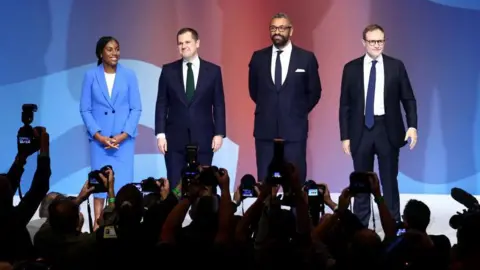Conservative leadership: How does the contest work and who chooses the winner?
 Getty Images
Getty ImagesThe four remaining candidates competing to become the next Conservative Party leader are Kemi Badenoch, Robert Jenrick, James Cleverly and Tom Tugendhat.
Rishi Sunak formally stood down after leading the Tories to their worst performance at a general election in July, but is staying on as acting leader until his replacement is chosen.
That person will be the sixth Tory leader in less than eight and a half years.
How were the Tory leadership candidates chosen?
Each candidate needed the support of at least 10 MPs to get on to the ballot, including a proposer and seconder. MPs could nominate only one candidate per round of voting.
This was a much lower bar than during the last leadership election in 2022, when hopefuls needed the backing of 100 MPs. Mr Sunak was the only one to enter the race with that level of support and so became the party leader.
There are currently 121 Tory MPs, but those who are also whips or sit on the executive of the backbench 1922 Committee could not nominate a candidate.
Applicants were also told they would each need to raise £200,000 for the party to progress to the final four.
On 29 July, the Conservative backbench 1922 Committee announced six contenders had met the requirements.
How did the six candidates become four?
After nominations closed on 29 July, candidates had five and a half weeks to try to impress their fellow MPs.
On 4 September, two days after Parliament returned, a first round of voting among Conservative MPs reduced the field from six to five contenders, with former home secretary Priti Patel – who came last – eliminated from the contest.
On 10 September, five became four, after a second Tory MP vote knocked out Mel Stride.
The final four had a number of opportunities to speak directly to Conservative members at the party’s conference in Birmingham.
How will the Tory leader be chosen?
Two further rounds of voting at Westminster will follow, on 9-10 October, to determine the final two contenders.
Assuming no one pulls out and two candidates remain, Conservative members will cast their vote between 15 October and 31 October to decide the winner.
They will make their choice via secure online voting, though this system has previously been criticised for its susceptibility to hackers and rogue state interference.
In recent years, party members have tended to pick the more right-wing candidate of the final two. In the first of two leadership elections in 2022, Mr Sunak consistently won more support from MPs than Liz Truss during each round before party members ultimately chose Ms Truss.
To be eligible to vote, party members must have been active for 90 days before the ballot closes and must have been party members when nominations opened.
The new leader of the Conservative Party will be announced on 2 November – at which point Mr Sunak will hand over the reins.
The winner will become the official leader of the opposition and the figurehead of the Conservatives’ efforts to rebuild the party.






